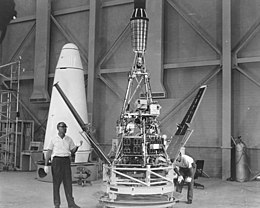 Ranger 1 Satellite in preparation for use at the Parade of Progress Show at the Public Hall, Cleveland, Ohio, August 1964 | |||||||||||||||||
| Mission type | Technology | ||||||||||||||||
|---|---|---|---|---|---|---|---|---|---|---|---|---|---|---|---|---|---|
| Operator | NASA | ||||||||||||||||
| Harvard designation | 1961 Phi 1 | ||||||||||||||||
| COSPAR ID | 1961-021A | ||||||||||||||||
| SATCAT no. | 173 | ||||||||||||||||
| Mission duration | 7 days | ||||||||||||||||
| Spacecraft properties | |||||||||||||||||
| Manufacturer | Jet Propulsion Laboratory | ||||||||||||||||
| Launch mass | 306.2 kilograms (675 lb) | ||||||||||||||||
| Power | 150.0 W | ||||||||||||||||
| Start of mission | |||||||||||||||||
| Launch date | August 23, 1961, 10:04:10 UTC | ||||||||||||||||
| Rocket | Atlas LV-3 Agena-B | ||||||||||||||||
| Launch site | Cape Canaveral LC-12 | ||||||||||||||||
| End of mission | |||||||||||||||||
| Decay date | 30 August 1961 | ||||||||||||||||
| Orbital parameters | |||||||||||||||||
| Reference system | Geocentric | ||||||||||||||||
| Regime | Low Earth (High Earth planned) | ||||||||||||||||
| Semi-major axis | 6,690.3 kilometres (4,157.2 mi) | ||||||||||||||||
| Eccentricity | 0.019939 | ||||||||||||||||
| Perigee altitude | 179 kilometres (111 mi) | ||||||||||||||||
| Apogee altitude | 446 kilometres (277 mi) | ||||||||||||||||
| Inclination | 32.9 degrees | ||||||||||||||||
| Period | 91.1 minutes | ||||||||||||||||
| Revolution no. | 110 | ||||||||||||||||
| |||||||||||||||||
Ranger 1 was a prototype spacecraft launched as part of the Ranger program of uncrewed space missions. Its primary mission was to test the performance of those functions and parts necessary for carrying out subsequent lunar and planetary missions; a secondary objective was to study the nature of particles and fields in the space environment. Due to a launch vehicle malfunction, the spacecraft could reach only Low Earth orbit, rather than the high Earth orbit that had been planned, and was only able to complete part of its mission.[1]